Key Takeaways
- Vibrant colors are deeply embedded in Latin American festive fashion, blending ancestral traditions with contemporary aesthetics.
- From Mexico’s vivid embroidery to Brazil’s tropical brights, each country boasts unique palettes, fabrics, and layering techniques that reflect local heritage and modern creativity.
- Incorporating these rich hues into your own wardrobe can be as simple as choosing statement accessories or pairing unexpected color combinations inspired by regional fiestas.
- Understanding the interplay of cultural motifs, textiles, and colors can elevate your style, making it both eye-catching and meaningful.
- Embrace the full color spectrum, experiment with textures, and celebrate the diversity of Latin American fashion to create a look that feels both authentic and timeless.

In a world where fashion often leans on predictable, muted tones, Latin America’s festive style traditions shine like vibrant fireworks in the night sky.
From the intricate embroidery on Mexican huipiles to the bold tropical prints of Brazilian beach attire, Latin American fashion is a striking tapestry of color-rich textiles, cultural motifs, and historical influences.
These countries don’t shy away from the daring side of the color wheel—instead, they embrace it wholeheartedly, weaving radiant hues into everyday clothing, festival costumes, and modern street looks.
Latin American festive fashion isn’t just about bright pigments; it’s about storytelling. Each brilliant shade can represent centuries-old traditions, indigenous heritage, or a contemporary spin on classic forms. The result: ensembles that celebrate the very soul of a country.
In this guide, we’ll explore the signature color palettes of fourteen iconic Latin American destinations. We’ll discover how traditional garments blend with modern trends, and how to translate these inspirations into a wardrobe that adds energy and character to your personal style.
So let’s dive in and uncover the brightest colors and styles that make Latin America’s fashion scene truly unforgettable.
Mexico: A Kaleidoscope of Embroidery and Textiles

Traditional Festive Attire & Signature Colors
Mexico’s festive attire bursts with rich reds, cobalt blues, and sunny yellows. Traditional garments like the huipil and charro suits often feature intricate floral embroidery and vivid geometric patterns. At markets, you’ll find rebozos and blouses adorned with magenta and emerald detailing, echoing centuries of indigenous artistry. These bright hues are not merely decorative—they connect the wearer to ancestral traditions and local celebrations like Dia de los Muertos and Guelaguetza.
Contemporary Street Fashion & Emerging Color Trends
Today’s Mexican fashionistas mix centuries-old techniques with fresh ideas. Modern silhouettes feature bold primary shades paired with neutrals, highlighting the vibrant patterns. Young designers experiment with color-blocked skirts and hand-painted jackets, blending new synthetic fabrics with organic cotton and handwoven textiles. Neon accents—especially hot pink, lime green, and tangerine—are making waves, contrasting beautifully against more subdued backgrounds.
Tips on Incorporating Mexican Color Inspiration
To channel Mexican flair, try layering embroidered scarves over a simple top. Accessorize with statement pieces like a hand-stitched belt or a vividly beaded necklace. For a polished look, combine a bright blouse with dark denim, or add a splash of color using patterned earrings. Embrace bold contrasts—team cobalt blue with sunflower yellow—to replicate Mexico’s love for luminous hues.
Guatemala: Rainbow-Hued Mayan Heritage

Traditional Festive Attire & Signature Colors
Guatemala’s textile artistry emerges from its indigenous Mayan roots. Traditional huipiles and cortes are alive with a rainbow of colors—scarlet, violet, jade, and saffron—often woven into intricate motifs symbolizing nature and community. Each village may have a distinctive palette, creating a mosaic of regional identities. Festivities see these garments worn proudly, highlighting detailed weaving techniques and natural dyes extracted from local flora.
Contemporary Street Fashion & Emerging Color Trends
Modern Guatemalans embrace their heritage while incorporating global trends. Street style effortlessly merges handwoven fabrics with contemporary silhouettes like fitted blouses or trendy jumpsuits. Earthy tones—chocolate, forest green—often pair with neon brights, reflecting Guatemala’s lush landscapes. In urban areas, we see bold color-blocking, geometric prints, and subtle metallic threads that bridge traditional craftsmanship with cosmopolitan flair.
Tips on Incorporating Guatemalan Color Inspiration
Try adding a handwoven shawl featuring multiple hues as a statement piece. Pair a vivid embroidered clutch with a monochrome outfit to let the fabric’s artistry shine. Introduce layered textures—mix a bright woven belt with a simple dress, or opt for earrings made from colorful natural beads. The goal is to add touches that celebrate heritage without overwhelming your look.
Brazil: Tropical Brights and Carnival Extravagance

Traditional Festive Attire & Signature Colors
Brazilian color palettes radiate energy, mirroring lush rainforests, vibrant flora, and Carnival’s electrifying spirit. Turquoise, fiery orange, canary yellow, and hot pink swirl together in costumes adorned with feathers, sequins, and ribbons. Festive attire, from Bahian dresses to Samba parade outfits, channels the country’s carnival ethos—unapologetically bold and delightfully over-the-top.
Contemporary Street Fashion & Emerging Color Trends
Today’s Brazilian street fashion takes these vibrant hues and tempers them with sleek silhouettes. Neon athletic wear, bright beach wraps, and tropical print trousers are common staples. Rio’s fashion scene embraces fluid fabrics like lightweight cotton and linen, pairing leafy greens and ocean blues with pops of bright magenta. Geometric patterns, gradient dyes, and fruit-inspired motifs (think papaya or pineapple prints) add a playful touch.
Tips on Incorporating Brazilian Color Inspiration
A bold tropical print skirt or a pair of statement earrings in neon hues can instantly invigorate your outfit. Experiment with mixing hot pink and bright yellow for a lively, Rio-inspired vibe. Add a lightweight scarf or headwrap in a lush jungle pattern. If you’re hesitant, start small: a single colorful bracelet or a belt with tropical embroidery can bring summery joy to any look.
Colombia: Vibrant Contrasts in Caribbean and Andean Style

Traditional Festive Attire & Signature Colors
Colombia’s sartorial diversity spans coastal Caribbean zones to mountainous Andean regions. Bright reds, emerald greens, royal blues, and sunny golds are woven into costumes like the pollera colora skirt. In coastal festivals, expect lively floral prints reflecting palm trees and hibiscus flowers, while highland attire might feature subtle earth tones accented by bursts of bright hand-embroidered details.
Contemporary Street Fashion & Emerging Color Trends
Urban Colombians love to experiment with mixed prints, layering geometric shapes and floral motifs. Street trends often highlight pastel backdrops punctuated by bright pops: think mint green shirts with cherry-red accessories. Tropical fruits inspire patterns—passionfruit yellows, watermelon pinks—while modern silhouettes, from sleek jumpsuits to tailored blazers, anchor these vibrant palettes.
Tips on Incorporating Colombian Color Inspiration
Opt for a patterned maxi dress that combines multiple hues, or pair a bright embroidered shawl with a neutral ensemble. Even a simple white tee can come alive with a multicolor belt. Aim for color balance—try one standout piece, like a bright pair of loafers or a flamboyant tote, complemented by understated neutrals. This approach brings a slice of Colombian vivacity to your everyday style.
Peru: Andean Artistry and Modern Minimalism

Traditional Festive Attire & Signature Colors
Peru’s traditional clothing—like the polleras, shawls, and chullos—often features deep, saturated shades: ruby reds, sapphire blues, forest greens, and gold accents. These hues highlight the majestic Andean landscapes and centuries-old weaving techniques. Embroidery may depict llamas, condors, or geometric Incan patterns, blending nature and history into a tapestry of colors and textures.
Contemporary Street Fashion & Emerging Color Trends
In Lima’s fashion scene, minimalism mingles with heritage. Neutral basics—cream blouses, navy trousers—get enlivened with artisanal accessories in brilliant shades. Earthy palettes inspired by the highlands and bold, blocky patterns referencing Incan motifs have become popular. Expect to see a mix of modern cuts with handwoven fabrics, combining the simplicity of urban style with touches of cultural richness.
Tips on Incorporating Peruvian Color Inspiration
Add a Peruvian-inspired woolen shawl or a belt with vibrant geometric patterns to a simple outfit. Consider a handbag woven by local artisans, highlighting traditional hues against a sleek dress. Even a pair of bold socks or a brightly colored headband can channel Peruvian flair. The key is blending modern minimalism with handcrafted color details that evoke mountain vistas and ancient art.
Bolivia: High-Altitude Hues and Intricate Embroidery

Traditional Festive Attire & Signature Colors
In Bolivia’s high-altitude festivals, attire features bright, jewel-toned hues—fuchsia, teal, canary, and amethyst—contrasting with darker grounding shades. Polleras (skirts) and shawls reflect local Aymara and Quechua traditions, often combining multiple bright colors in stripes or geometric patterns. These vibrant looks are celebrations in themselves, worn during carnivals and religious festivities that fill the streets with a rainbow of woven artistry.
Contemporary Street Fashion & Emerging Color Trends
Bolivian youth merge these intense colors with casual streetwear. You’ll find denim jackets adorned with woven patches, sneakers featuring embroidered motifs, and T-shirts paired with vibrant scarves. Monochrome outfits gain life through a single, brilliantly tinted accessory. Metallic threads have gained popularity, adding a modern shimmer to traditionally matte textiles.
Tips on Incorporating Bolivian Color Inspiration
Pick a single focal piece, like a handwoven hat or a bright, richly patterned scarf, to add Bolivian flair to your look. Don’t hesitate to experiment with unexpected color combinations—pair magenta with emerald or teal with mustard. Adding a touch of embroidery, such as a woven handbag strap, can bring texture and color depth, hinting at Bolivia’s mountain festivals and artisanal crafts.
Chile: Subtle Elegance and Coastal Vividness
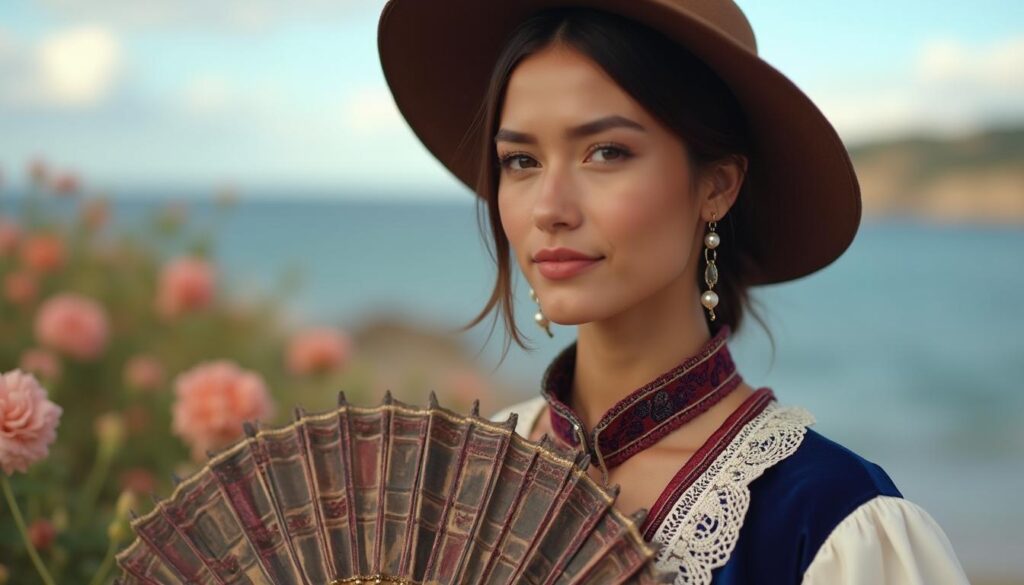
Traditional Festive Attire & Signature Colors
Chilean traditional attire, like the chamanto and the cueca dance costumes, often features a blend of deep blues, rich burgundies, and crisp whites. The colors echo the dramatic contrasts of the country’s geography: snow-capped peaks, fertile valleys, and a stunning coastline. Florals, stripes, and poncho patterns subtly incorporate accent colors that feel both grounded and celebratory.
Contemporary Street Fashion & Emerging Color Trends
Chile’s modern fashion scene leans toward subtlety with pops of brightness. You’ll see navy blazers with a burst of orange in pocket squares, or minimalist dresses accented by bright red belts. Urban dwellers prefer quality fabrics—soft cotton, alpaca wool—decorated sparingly. Coastal influences bring nautical stripes, aqua accents, and breezy silhouettes, blending refinement with a hint of coastal spirit.
Tips on Incorporating Chilean Color Inspiration
A sleek navy dress can be brought to life with a bold, contrasting scarf in burgundy or bright red. Add a statement brooch or belt that nods to Chile’s vibrant accent hues. If you prefer a more casual look, choose a striped top in marine colors and pair it with colorful handmade jewelry. The idea is subtle sophistication with well-chosen bursts of color.
Argentina: Bold Tango Tones and Sophisticated Street Style

Traditional Festive Attire & Signature Colors
Argentine traditional dress can range from the dramatic reds and blacks of tango attire to rustic gaucho ensembles. Crimson, black, white, and earthy browns dominate, reflecting both passionate dance culture and the rugged Pampas. Tangos’ vivid red accentuates flowing skirts and ruffled details, while festival attire might incorporate embroidered belts and hats inspired by ranching traditions.
Contemporary Street Fashion & Emerging Color Trends
In Buenos Aires, cosmopolitan chic rules. You’ll find sleek black trousers offset by a bold red scarf, or a white linen shirt paired with statement accessories in teal or fuchsia. Streetwear often melds European-influenced minimalism with Latin American warmth. Floral patterns and striped fabrics appear in muted palettes, with a single pop of bright color capturing attention.
Tips on Incorporating Argentine Color Inspiration
A simple black dress can be elevated by a red shawl or a pair of red heels. For everyday flair, a subtle embroidered belt or a patterned handkerchief adds a distinct Argentine touch. Consider blending neutral basics—black pants, white tees—with one vivid element, like a red clutch, for a look that feels both refined and delightfully dynamic.
Ecuador: Earthy Tones and Tropical Highlights

Traditional Festive Attire & Signature Colors
Ecuador’s textiles often blend rustic earth tones—terra-cotta, moss green, ochre—with unexpected bursts of turquoise or magenta. From the Andean highlands to the Amazonian lowlands, garments reflect local resources and terrain. Ponchos, shawls, and hats incorporate warm, rich hues, while coastal celebrations might showcase brighter, tropical influences with floral embroidery and lighter fabrics.
Contemporary Street Fashion & Emerging Color Trends
Modern Ecuadorian fashion cleverly balances heritage with contemporary style. Earthy browns and beiges might form the base of an outfit, with accessories in electric blue or fuchsia. You’ll see eclectic patterns—botanical prints, geometric shapes—on tunics, skirts, and bags. Younger designers are adding splashes of metallic thread and experimenting with synthetic fabrics that highlight Ecuador’s natural pigments.
Tips on Incorporating Ecuadorian Color Inspiration
Think layering: a neutral sweater with a bright woven scarf, or beige trousers paired with a colorful tote. A statement necklace in turquoise or a magenta-trimmed jacket can echo Ecuador’s diverse palette. Let one or two bright accents stand out against a backdrop of natural tones, making the vivid hues feel intentional and artful.
Cuba: Caribbean Pastels and Vintage Vibes

Traditional Festive Attire & Signature Colors
Cuban traditional wear, like the guayabera shirts and ruffled dresses, often plays with soft pastels—mint green, baby blue, pale pink—and bright yellows and reds. Celebrations frequently include flowing fabrics suited to the island’s warm climate, with embroidered details adding texture and subtle flair. Think breezy cotton dresses with a sunflower accent or linen shirts in sorbet shades.
Contemporary Street Fashion & Emerging Color Trends
Modern Cuban style reflects a retro charm influenced by the island’s vintage cars and colonial architecture. Pastel trousers pair with crisp white tops, and airy skirts feature delicate floral prints. Accents in bolder hues—scarlet headwraps, cobalt sandals—add a punch to these gentle tones. Lightweight fabrics and natural fibers keep outfits comfortable yet eye-catching.
Tips on Incorporating Cuban Color Inspiration
Try mixing a pastel linen shirt with white pants, then add a small burst of color—like a red belt or a bright scarf. Opt for vintage-inspired silhouettes and breathable fabrics. Soft colors can be combined with one or two bright accents to create a look that’s relaxed, sunny, and evocative of Havana’s spirited streets.
Puerto Rico: Tropical Prints and Island Elegance
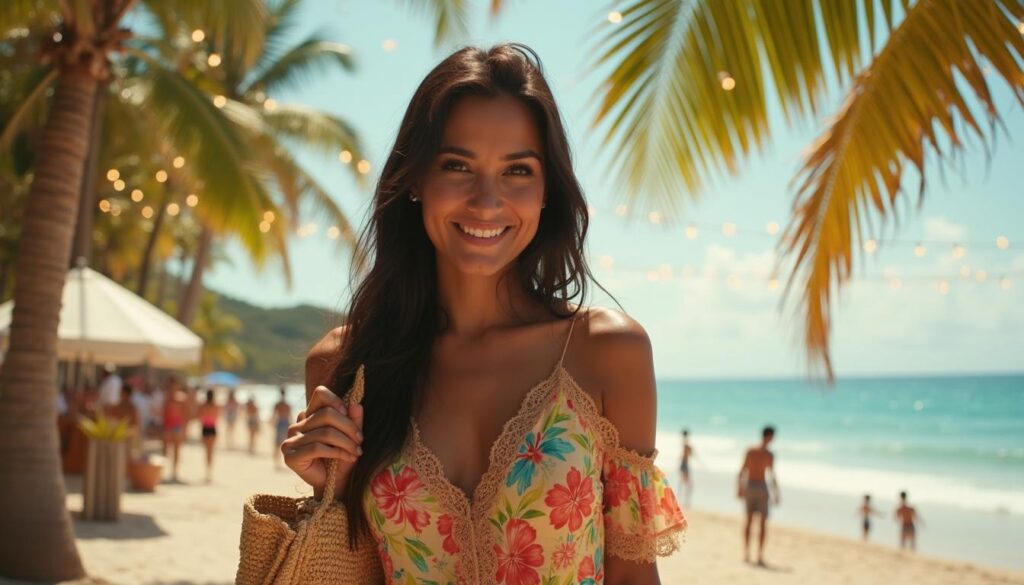
Traditional Festive Attire & Signature Colors
Puerto Rico’s festive attire often features bold island colors—turquoise, coral, chartreuse—and vibrant floral patterns. Traditional blouses and skirts celebrate the island’s lush greenery and clear waters. Ruffles, lace details, and bright embroidery all add to the festive mood seen in events like Fiestas Patronales or Navidad celebrations.
Contemporary Street Fashion & Emerging Color Trends
Modern Puerto Rican fashion blends island casual with contemporary edge. Expect to see tropical print jumpsuits, linen pants in bright coral, and breezy dresses adorned with hibiscus motifs. Metallic sandals and lightweight shawls add sophistication. Color-blocking with contrasting tropical hues, and incorporating straw hats or woven bags, keeps outfits fresh and relevant.
Tips on Incorporating Puerto Rican Color Inspiration
A tropical print blouse paired with neutral trousers can bring a piece of paradise to your everyday look. Consider a coral skirt or a turquoise scarf for a splash of island flair. Lightweight fabrics and natural fibers ensure comfort and authenticity. Even a pair of colorful beaded earrings inspired by island flora can add a charming twist to an otherwise simple outfit.
Dominican Republic: Merengue Rhythms and Colorful Textiles

Traditional Festive Attire & Signature Colors
Dominican attire often mirrors the vivacious energy of merengue and bachata. Bright whites, royal blues, fiery reds, and lush greens dominate. Festival dresses may include layered skirts trimmed with lace and embroidery, echoing the island’s musical exuberance and cultural pride. These colors reflect the Dominican Republic’s shimmering beaches, fertile valleys, and vibrant cityscapes.
Contemporary Street Fashion & Emerging Color Trends
In Santo Domingo’s streets, casual T-shirts might be paired with bright accessories—beaded belts, embroidered sneakers. Tropical patterns—palm leaves, mango shapes—and maritime stripes playfully adorn skirts and scarves. Metallic touches and sequin details occasionally appear, adding a celebratory shimmer. The result is a friendly, approachable style infused with Caribbean color.
Tips on Incorporating Dominican Color Inspiration
Try pairing a crisp white shirt with a vivid red skirt or a bright blue scarf. Add a piece of jewelry in green or gold to highlight the island’s lush palette. For a bolder approach, mix a tropical-patterned accessory with neutral basics. This blending of confident colors and easy-going fabrics creates a sunny, carefree vibe that’s instantly appealing.
Venezuela: Coastal Hues and Inland Riches

Traditional Festive Attire & Signature Colors
Venezuela’s traditional outfits often feature sunny yellows, bold blues, and vibrant reds, reflecting the national flag’s colors and diverse landscapes. Coastal festivals incorporate breezy fabrics and bright motifs inspired by the Caribbean Sea. Inland celebrations might highlight earthier tones balanced by a few striking accents. Embroidery, lace, and pleated details bring the clothing to life.
Contemporary Street Fashion & Emerging Color Trends
In modern Venezuela, bright palettes remain strong. Street style often features color-blocking with primary shades—royal blue pants, red blouses, yellow accessories—tempered by denim or khaki for balance. Florals, tropical leaf prints, and playful polka dots also appear. Lightweight materials, from cotton to linen blends, ensure comfort in warm climates.
Tips on Incorporating Venezuelan Color Inspiration
Don’t hesitate to experiment with primary colors. A yellow scarf or red handbag can breathe new life into a familiar outfit. If you prefer subtlety, try a floral headband or a brightly embroidered clutch. Incorporating one or two bold accents gives your style a Venezuelan spark, connecting your look to a culture that embraces color’s joyful potential.
Panama: Canal-Inspired Blues and Indigenous Craftsmanship

Traditional Festive Attire & Signature Colors
Panamanian traditional dresses, like the pollera, often showcase stark whites contrasted with bold accent colors—crimson, royal blue, emerald—applied in intricate embroidery and lacework. Indigenous influences introduce geometric motifs and bright hues reflecting local flora and fauna. The interplay of white with pops of vibrant color creates a refined yet celebratory look, especially during national festivals.
Contemporary Street Fashion & Emerging Color Trends
In Panama City’s modern fashion scene, white linen pants or cotton shirts might be paired with vivid accessories—scarves, belts, and necklaces that feature geometric patterns in bright blues or greens. Coastal influences inspire nautical stripes, while the city’s cosmopolitan edge brings in structured silhouettes and high-quality fabrics. Metallic details and embroidered patches also find their way into everyday style.
Tips on Incorporating Panamanian Color Inspiration
Start with a crisp white base—like a white shirt or dress—and add bold accents: a colorful belt or a scarf with indigenous patterns. Consider a pair of statement earrings or a woven handbag in bright turquoise. Subtle hints of color against a clean backdrop can evoke the essence of Panama’s festive elegance and cultural richness.
Honduras: Coastal Blues and Earthy Accents

Traditional Festive Attire & Signature Colors
In Honduran celebrations, you’ll find deep blues, lush greens, and earthy browns woven into garments inspired by both Caribbean coasts and mountainous interiors. Traditional outfits like the güipil often feature subtle embroidery and simple silhouettes that highlight local craftsmanship and natural dyes, reflecting the country’s ties to the sea and fertile land.
Contemporary Street Fashion & Emerging Color Trends
Modern Hondurans fuse traditional tones with contemporary cuts. Denim and cotton basics in neutral shades become canvases for bright accessories—think a teal shawl or coral earrings. Local designers experiment with tropical prints showcasing palm fronds and birds of paradise in vivid hues, while maintaining a grounded feel through earthy undertones and well-structured silhouettes.
Tips on Incorporating Honduran Color Inspiration
Start by pairing a neutral outfit with a single statement piece in aqua or emerald. A woven belt or handbag with subtle embroidery can bring natural warmth to your look. Combine earthy browns with a pop of Caribbean blue for a breezy, fresh vibe that’s effortlessly wearable.
El Salvador: Volcanic Tones and Vibrant Contrasts

Traditional Festive Attire & Signature Colors
El Salvador’s volcanic landscapes inspire bold reds, smoky grays, and forest greens. Traditional costumes, worn during festivals and parades, often integrate embroidered floral motifs and geometric patterns in vivid threads. The result is a rich interplay of warm and cool tones that mimic the country’s dramatic scenery—think ruby accents against charcoal fabrics.
Contemporary Street Fashion & Emerging Color Trends
Today, Salvadoran street style balances vibrant elements with minimalist basics. Black jeans get paired with a bright red blouse, while simple white shirts might be enlivened by emerald scarves. Subtle touches of metallic thread or tiny beaded details add texture. Tropical fruit motifs, in mango yellows or papaya oranges, appear on accessories for a flavorful twist.
Tips on Incorporating Salvadoran Color Inspiration
Try a charcoal-gray dress with a red or green embroidered shawl. If you prefer subtlety, choose accessories like a beaded necklace in warm hues to nod to volcanic tones. Integrating a single piece with a standout hue can channel El Salvador’s unique color story without overwhelming your ensemble.
Nicaragua: Lake-Inspired Blues and Tropical Warmth

Traditional Festive Attire & Signature Colors
Nicaraguan festivities often feature lake-inspired blues, sunny yellows, and lush greens, reflecting the country’s abundant freshwater and tropical forests. Traditional garments, such as embroidered skirts or embroidered tops, may include floral or avian motifs stitched in bright threads. The palette exudes a gentle, cheerful warmth perfectly suited to the climate.
Contemporary Street Fashion & Emerging Color Trends
Modern Nicaraguans often blend easygoing basics with pops of vibrant color. Simple cotton dresses are accented by statement accessories—perhaps earrings in cobalt blue or sandals in sunflower yellow. Younger designers experiment with digital prints of local flora, translating traditional motifs into contemporary patterns that appeal to a global audience.
Tips on Incorporating Nicaraguan Color Inspiration
Consider pairing a light, airy dress with a brightly colored scarf reminiscent of the country’s lush greenery. Even a handbag or pair of shoes in a striking blue or green can convey a sense of freshness and vitality. Keep fabrics breathable and silhouettes relaxed to capture the essence of Nicaragua’s laid-back style.
Costa Rica: Eco-Friendly Hues and Jungle Motifs
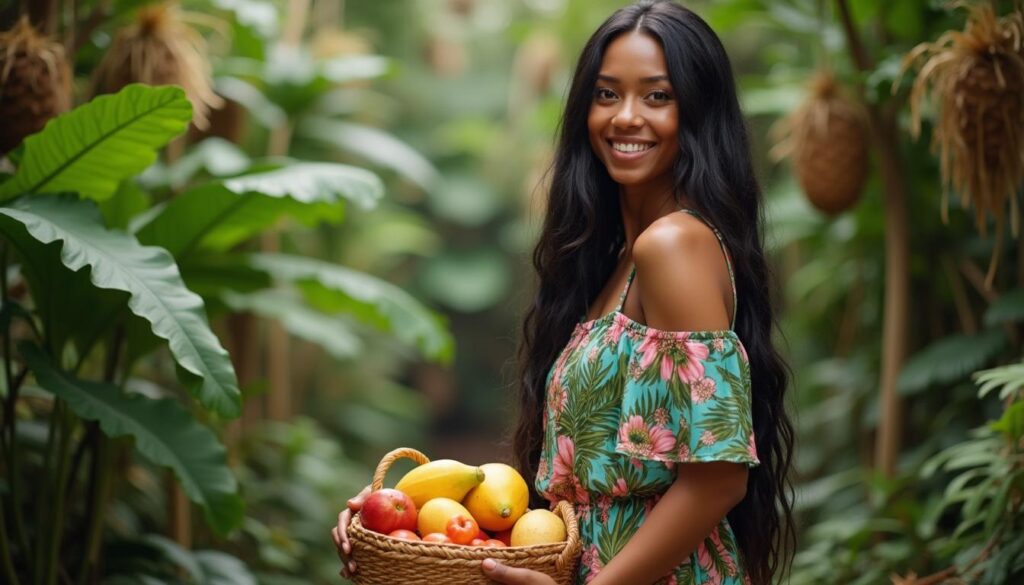
Traditional Festive Attire & Signature Colors
Costa Rica’s celebrations channel jungle greens, orchid pinks, and sky blues, reflecting the nation’s renowned biodiversity. Traditional attire may be simpler than in other countries, but embroidered details and subtle patterns highlight nature’s influence—leaves, flowers, and birds in vivid, tropical palettes.
Contemporary Street Fashion & Emerging Color Trends
Contemporary Costa Rican style leans into sustainability and natural fabrics. Linen shirts, cotton skirts, and eco-friendly materials set the stage, with a bright belt or printed scarf delivering the color punch. Designs often incorporate botanical prints, blending local flora with modern cuts for an effortless, nature-inspired look.
Tips on Incorporating Costa Rican Color Inspiration
Start with a neutral base—perhaps a beige linen top—and layer in color through accessories like a green tote or a floral scarf. A pair of bright sandals or a headband featuring tropical blossoms can capture Costa Rica’s essence. Embrace breathable fabrics and fresh hues to reflect the country’s natural vibrancy and ecological pride.
Paraguay: Guaraní Heritage and Rich Reds

Traditional Festive Attire & Signature Colors
Paraguayan festivities often highlight deep reds, navy blues, and crisp whites, reflecting both Spanish colonial and indigenous Guaraní influences. Traditional ao po’i blouses and lacework incorporate fine detailing, while embroidered motifs in red or blue stand out against a pale background, evoking both cultural heritage and natural landscapes.
Contemporary Street Fashion & Emerging Color Trends
Modern Paraguayan outfits combine comfort and elegance. White dresses adorned with subtle red embroidery or a navy blazer accented by a bright red scarf illustrate this balance. Designers also experiment with delicate lace patterns and geometric prints, adding contemporary flair while honoring craftsmanship.
Tips on Incorporating Paraguayan Color Inspiration
A white blouse with a red-embroidered collar or a simple dress paired with a vivid blue belt can subtly channel Paraguayan style. Introduce lace details for texture or choose small pops of red to complement neutral tones. This approach lets you celebrate Paraguay’s refined yet dynamic aesthetic in a wearable way.
Uruguay: Coastal Chic and Pastel Sophistication
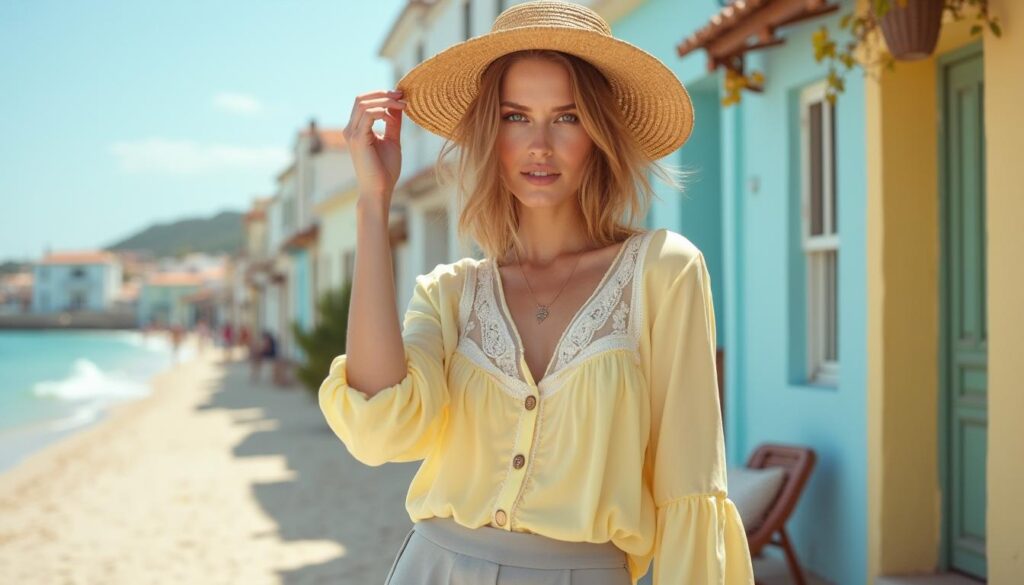
Traditional Festive Attire & Signature Colors
Uruguay’s coastal charm influences soft blues, pastel yellows, and gentle grays, often seen in the simple yet elegant attire. Festivals highlight loose-fitting dresses and shawls with understated embroidery, while fishermen’s sweaters and scarves recall the country’s maritime heritage, adding subtle texture rather than overwhelming color.
Contemporary Street Fashion & Emerging Color Trends
Modern Uruguayan fashion favors understated elegance. Neutral palettes get a lift from a pastel sweater or scarf, and well-tailored trousers pair easily with a lavender blouse. Designers often embrace minimalism, letting a single pastel item become the focal point—perfect for those who prefer quieter expressions of color.
Tips on Incorporating Uruguayan Color Inspiration
Choose a soft blue sweater or a pale yellow scarf to brighten a neutral outfit. If you prefer minimalism, a single pastel accessory can capture Uruguay’s delicate coastal essence. Seek quality fabrics and simple silhouettes, ensuring each colorful accent feels intentional and elevated.
Suriname: Cultural Fusion and Rainforest Radiance

Traditional Festive Attire & Signature Colors
Suriname’s multicultural society embraces a vibrant spectrum—emerald greens, saffron yellows, bright reds, and cobalt blues—reflecting African, Asian, and Indigenous influences. Traditional wraps and headscarves showcase intricate prints and radiant hues, celebrating a rich tapestry of cultural heritage united by bold color choices.
Contemporary Street Fashion & Emerging Color Trends
In Paramaribo’s streets, you’ll find a delightful blend of global styles: bright batik prints, cotton tees in vivid shades, and skirts with botanical patterns. Youthful designers draw from Suriname’s rainforest biodiversity and cultural mosaic, experimenting with block prints, hand-dyed textiles, and artisanal beadwork, all in a riot of joyful colors.
Tips on Incorporating Surinamese Color Inspiration
Embrace a bolder approach—pair a vibrant printed scarf with a simple outfit or opt for a richly colored wrap skirt. Don’t shy away from mixing several colors at once, as long as they share a theme or pattern. Let your accessories tell a multicultural story through their radiant palette.
Guyana: Caribbean-Inspired Brights and Indigenous Roots

Traditional Festive Attire & Signature Colors
Guyana’s traditional garments draw from Indigenous and Caribbean influences, merging lush greens, sunny yellows, cherry reds, and ocean blues. Feathered headdresses, richly patterned wraps, and embroidered tops highlight flora, fauna, and geometric motifs, capturing the country’s dense forests and sparkling coastlines.
Contemporary Street Fashion & Emerging Color Trends
Modern Guyanese fashion pairs everyday basics with vivid accent pieces. Think denim shorts with a bright yellow scarf or a white tunic decorated with a tropical print. Designers experiment with color-blocking and hand-painted fabrics. Accessories featuring local wood, seeds, or shells add earthy depth to the cheerful hues.
Tips on Incorporating Guyanese Color Inspiration
Try mixing primary colors—like blue and yellow—in small doses. A brightly patterned headwrap or a colorful beaded necklace can nod to Guyana’s diverse heritage. Focus on natural materials, tropical motifs, and confident color combinations that bring the lush, adventurous spirit of the country into your style.
Country Color Highlights & Style Tips
| Country | Key Colors | Style Tip |
|---|---|---|
| Mexico | Rich reds, cobalt blues, sunny yellows | Embroidered accessories to brighten neutrals |
| Guatemala | Scarlet, violet, jade, saffron | Handwoven shawls & belts for layered texture |
| Brazil | Turquoise, fiery orange, canary yellow, hot pink | Tropical prints & bold contrasts to channel Carnival energy |
| Colombia | Bright reds, emerald greens, royal blues, gold | Pair pastels with vibrant accents for balanced boldness |
| Peru | Ruby reds, sapphire blues, forest greens, gold | Minimalist base + artisanal woven accessories |
| Bolivia | Fuchsia, teal, canary, amethyst | One statement accessory for an instant festival vibe |
| Chile | Deep blues, burgundies, crisp whites | Understated elegance with a single vibrant pop |
| Argentina | Crimson, black, white, earthy browns | Neutral attire elevated by a bold red accent |
| Ecuador | Earthy ochres, moss green, terra-cotta, turquoise | Neutral outfits + vivid woven accents |
| Cuba | Pastels (mint, baby blue, pale pink) & bright yellows | Vintage silhouettes + a bright detail for island charm |
| Puerto Rico | Turquoise, coral, chartreuse | Tropical prints & light fabrics for island breeziness |
| Dominican Republic | Bright whites, royal blues, fiery reds, greens | Crisp white base with lively accessories |
| Venezuela | Sunny yellows, bold blues, vibrant reds | Color-blocked primaries balanced with neutrals |
| Panama | White with crimson, royal blue, emerald accents | Clean white base + indigenous-inspired accessories |
| Honduras | Deep blues, lush greens, earthy browns | Neutral outfit + a single vibrant Caribbean-hued item |
| El Salvador | Bold reds, smoky grays, forest greens | Charcoal base accented by a warm or cool vivid accessory |
| Nicaragua | Lake blues, sunny yellows, lush greens | Bright accessory on airy fabrics for a fresh tropical look |
| Costa Rica | Jungle greens, orchid pinks, sky blues | Eco-friendly fabrics + a pop of tropical color |
| Paraguay | Deep reds, navy blues, crisp whites | Lace details + a red or blue highlight on neutrals |
| Uruguay | Soft blues, pastel yellows, gentle grays | Minimalist neutrals with one pastel accent |
| Suriname | Emeralds, saffron yellows, bright reds, cobalt blues | Multicolor prints & bold combos to reflect cultural fusion |
| Guyana | Lush greens, sunny yellows, cherry reds, ocean blues | Natural materials & confident color-blocking for tropical flair |
Conclusion
Latin American festive fashion is a dynamic universe of brilliant hues, intricate patterns, and deep cultural significance. Each country we’ve explored offers a distinct color story, weaving together history, geography, and tradition into a wearable art form. From Mexico’s daring embroidery to Brazil’s carnival extravagance, and from the Andean artistry of Peru to Cuba’s vintage pastels, these looks transcend mere trendiness.
What unites these diverse styles is a fearless embrace of color—whether expressed through vibrant accessories, patterned textiles, or full-on color-blocking. These styles invite you to step outside your comfort zone, exploring how a single bold shade or a carefully chosen pattern can enliven your entire wardrobe. By integrating Latin American color inspiration into your personal style, you not only celebrate stunning aesthetics but also honor the rich cultural narratives behind each hue and motif.
This colorful journey encourages creativity, confidence, and a willingness to experiment. As you blend these inspirations into your own looks, remember: the goal isn’t to replicate exactly, but to reimagine. Let the radiant colors of Latin America guide you toward fresh fashion choices that feel alive, meaningful, and undeniably vibrant.
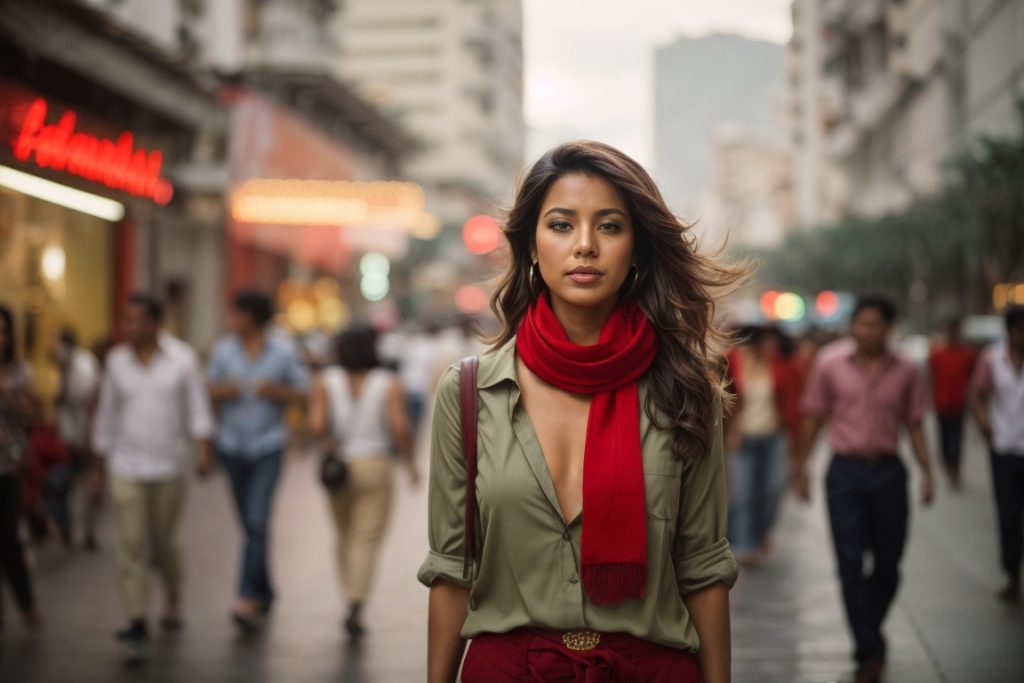
FAQ
Q: How can I start incorporating these vibrant Latin American colors if I usually wear neutrals?
A: Start small. Add a brightly colored scarf, belt, or handbag to your neutral ensemble. Over time, experiment with bolder statement pieces like a patterned skirt or embroidered jacket. Gradual steps make it easier to build confidence in mixing bright hues.
Q: Can I mix influences from different countries into a single outfit?
A: Absolutely. Fashion is about personal expression. Combining a Mexican-inspired embroidered belt with a Guatemalan woven shawl, for example, can create a unique, multicultural look. Just ensure the pieces share a common color or pattern element to maintain harmony.
Q: Are these traditional textiles and garments widely available outside their countries of origin?
A: Many artisans and local designers sell their work online, making it easier than ever to find authentic pieces. Look for fair-trade stores, reputable online marketplaces, or local boutiques that specialize in Latin American crafts. Supporting these artisans helps preserve cultural traditions.
Q: What if I’m not comfortable wearing super-bright colors?
A: Incorporating brightness doesn’t mean you must go neon head-to-toe. Start with muted versions of those colors—softer pinks, gentler blues—and add only one or two vibrant elements. Over time, as you grow more comfortable, you can experiment with bolder shades.
Q: How can I ensure these colorful pieces fit into my existing wardrobe?
A: Identify a few colors you gravitate towards—maybe turquoise or red—and seek pieces in those tones. Also, look for patterns that include neutrals already present in your closet. This way, the new colorful additions complement what you already own, making styling simpler and more cohesive.
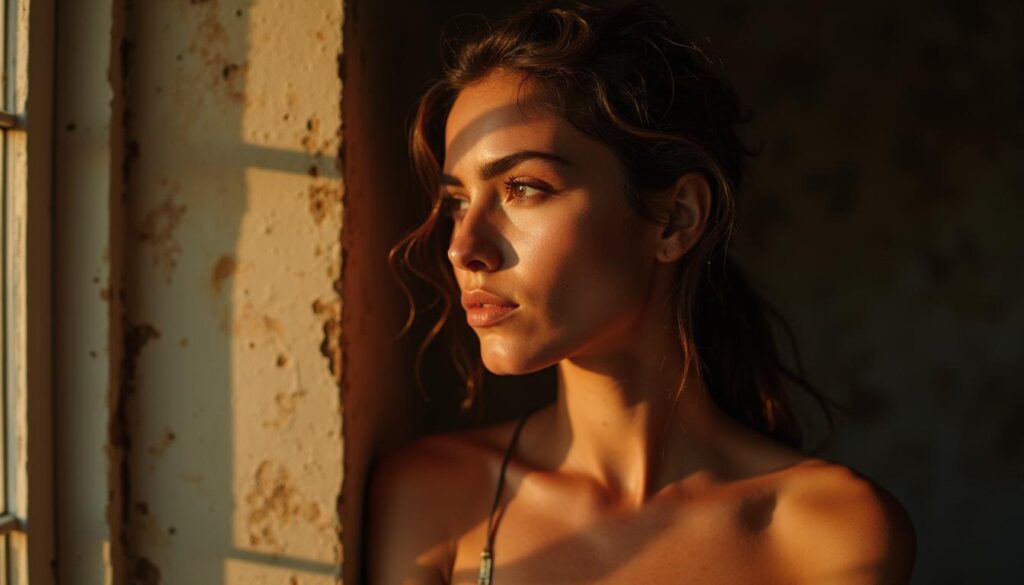
This journey through Latin American festive fashion reveals that incorporating bold colors and cultural patterns is both exciting and accessible. Allow these radiant hues to enliven your personal style, celebrate heritage, and inspire fresh looks that brim with creativity and warmth. Let the fiesta begin!

Marcella Raskin is a talented writer and editor with a deep passion for the dynamic realm of clothing colors and patterns. Armed with a strong background in Journalism, she crafts engaging content that empowers readers to select the perfect shades for their outfits. Her pieces provide an in-depth exploration of color trends and expertly curated fashion advice. Beyond her work, Marcella loves discovering new places, connecting with local designers, and advocating for sustainable fashion choices. She is devoted to helping individuals make enlightened color choices for their attire.
Reviewed By: Joanna Perez and Anna West
Edited By: Lenny Terra
Fact Checked By: Matthew Mansour
Photos Taken or Curated By: Matthew Mansour
